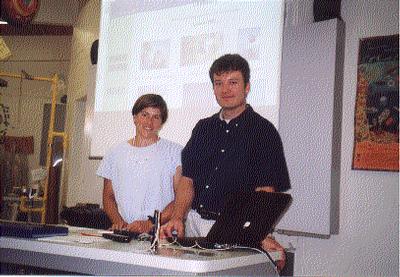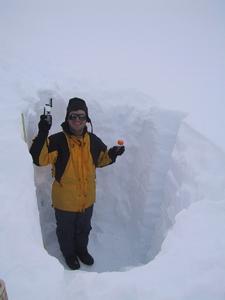8 August, 2001
Sparkle of humor and the "fogcatcher" experiment - Manuel Hutterli
Dream it, build it, refine it. It seems like everything that we do here
involves some sort of creative spirit. Steps are made of snow, Latex
gloves become party decorations, bamboo poles are used for all types of
structures and markers. Even the instruments used by the scientists are
each one of a kind. This creativity and ingenuity is usually coupled with
a wonderful sense of fun. My guess is that one would never survive in
such a place without the ability to laugh at adversity, make fun from
nothing and see things in the best light possible. The work is serious;
everyone is here because it is part of their career, but the sparkle of
fun isn't tarnished by the long days and harsh conditions, in fact, it
may be magnified.
A week ago, August 1 st, brought a new crew of scientists and support
staff to camp. The camp population grew from 21 to 30 people. This
infusion of new people brought with it the sense that the summer science
season was entering its last chapter. The energy level of the fresh
faces and projects has given us all a boost. The music plays more loudly
in the labs and office spaces, people are working long hours, laughing
often, and appreciating the chance to see the sunset over the horizon.
Of the people who came on the last flight, one was Manuel Hutterli from
the University of Arizona. Manuel is quite experienced in climate
science and traveling to the polar regions. He has been to Antarctica on
two occasions and this is his seventh trip to Summit. In the past twelve
months, Manuel has been to both poles twice each! Manuel, has his PhD in
Climate and Environmental Physics from the University of Bern in
Switzerland. He is a premier researcher in the area of the behavior of
the gases HCHO and H2O2 in the atmosphere. He was here in February and
March for 5 weeks, when the sun returned to Summit, to see the effects of
the polar sunrise on the snow and atmospheric chemistry. This is Manuel's
second trip to Summit this year. Manuel has come to help train the winter
over staff on the use of his instruments that will remain here at Summit
throughout the entire year. Manuel will also be presenting a talk at a
conference of researchers at the end of the season in Kangerlussauq.
Manuel's family are originally from Bern, Switzerland. His parents are
both teachers. His father, Kurt, a writer and artist and his mother,
Marianne a teacher of French. They now live in British Columbia, but
maintain a dual citizenship and a home in Switzerland. Manuel's sister,
Priska, is trained in library science and now runs a bookstore in Zurich.
Unlike the rest of his family, Manuel decided in fifth grade that he
wanted to become an astronomer. He was and still is an avid amateur
astronomer. He pursued his dream through high school by choosing the
science program at the gymnasium Kirchenfeld. Manuel studied both
Physics and Math. After high school, he continued his studies at the
University of Bern where he received both his masters and PhD in Climate
and Environmental Physics.
Along with his talent and intensity for science, Manuel brings with him a
delightful sense of humor and fun. I knew when we first met in February
that Manuel didn't fit my perception of a scientist. Like fresh snow in
the evening sunlight, he simply sparkles. He mixes fun into everything
that he does. There is a different feel to science and the work that he
does. Manuel is creative and artistic. This creativity is evidenced in
everything that he does. His photographs of the Summit station are
breathe-taking. He has an enormous collection of music on his computer,
and spends the evening entertaining us with his musical selections.
Manuel is quick and witty with jokes in both English and his native Swiss
German. Even though there is much to be done here, Manuel never misses a
chance to have fun. For instance, a couple of days ago, when the wind
returned to Summit, Manuel and I were busy working on our computers in
the lab. All of a sudden Manuel spun around in his chair and announced
we were going out to fly his kite. This kite is more like a sail or a
parachute. We took it out to the fresh and open snow and let it pull us
along on our skiis for a few hours. It was a wonderful chance to get away
and forget the work for a while, returning refreshed and ready to go back
to the more focused tasks that waited while we had fun.
Manuel's creativity is also found in his work. For example, all of
Manuel's instruments for his research are of his design. He can
constantly be found building or tinkering with some instrument. He
builds new instruments whenever we need one. We have been interested in
how much H2O2 the fog that is deposited at night contains, so for this
experiment, Manuel designed a simple but elegant, fog catcher made of
Teflon ropes strung at several heights above the snow. First Manuel sees
a question in need of an answer. then not long afterwards a vision of how
to answer it emerges and soon thereafter, an instrument is created.
Although these last years have been very full with trips and travel to
the Polar regions, Manuel enjoys hiking in his free time. Earlier this
summer, his mother joined him for a multi day hike in the Arizona
wilderness. Manuel hopes to return to his native Switzerland in the next
few years where he can ski and hike in the Alps. For now he is bringing
sparkle and creativity to the research at Summit as I am sure he does
everywhere he goes.
update on the fog catcher 8/12/01
Today we analyzed our first samples from the fog catcher. The fog catcher
is a series of three Teflon ropes strung between two bamboo poles. They
are strung at three heights to see if there is a variation in the
concentration of H2O2 in the fog at different elevations above the snow.
Our initial analysis showed that the concentration of H2O2 varies with
height! This piece of data should mesh nicely with Markus' gradient
studies.

Manuel visiting Phoenix Country Day School in May 2001.

Manuel blows out the candles on the birthday cake we shared. His birthday was August 7th and mine was on the 4th.

Manuel in the lab with the snow and air analysis instruments.

Manuel rebuilding one of his instruments for the winter season. He can build and repair any instrument here. Earlier this season he completely rebuilt the linear spectometer that had bad electronics in it. It saved our snow analysis.

In the snow pit. He is burying the schott bottle with a note in it for our silly ice flow experiment.
Contact the TEA in the field at
.
If you cannot connect through your browser, copy the
TEA's e-mail address in the "To:" line of
your favorite e-mail package.
|
